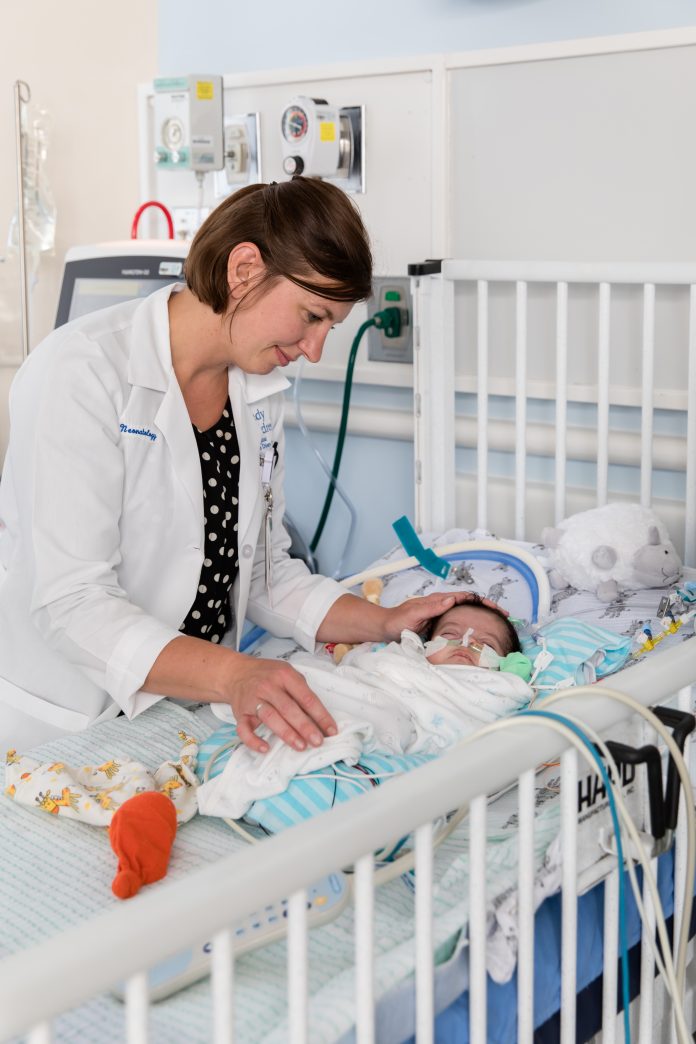
Nathan Aguirre weighed just 2 pounds, 15 ounces at birth in October 2018. After referral to the neonatal intensive care unit at Bakersfield Memorial Hospital in California and initial testing failed to pinpoint his condition, Nathan came close to the 5 pounds he needed for discharge. But when Nathan began bottle feeding, he began to experience seizures that his doctors also could not, at first, explain.
Doctors rushed Nathan 130 miles north to Valley Children’s Hospital in Madera. There, the seizures—later identified as dystonia—became less frequent, from once daily to once every couple of weeks. Nathan’s parents, Pamela Aguirre and Armando Martinez, got word from the chief geneticist treating Nathan that his condition was the first of its kind she had ever seen, and initial tests failed to reveal the source of his seizures.
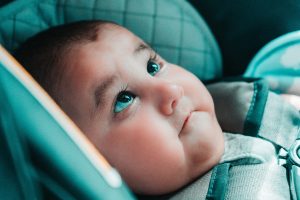
The geneticist also discussed a pilot program offering rapid whole-genome sequencing (rWGS) for critically ill newborns whose families are enrolled in the California Medical Assistance Program (Medi-Cal).
“Immediately, I was like, ‘Yes!’ Whatever needs to be done for us to find out what’s going on with him,” Martinez recalls.
Through the pilot program, Project Baby Bear, California became the first U.S. state to offer rWGS for critically ill newborns. Funded by the state in July 2018, with sequencing starting that fall, The pilot program used rWGS provided by Rady Children’s Institute for Genomic Medicine (RCIGM) to analyze the genetic code of 178 infants whose families are enrolled in Medi-Cal.
RCIGM operates within Rady Children’s Hospital-San Diego—the nation’s sixth largest children’s hospital—and maintains its own and one of five hospitals with California Children’s Services accredited regional (Level IV) neonatal and pediatric intensive care units (ICUs) that participated in Project Baby Bear.
By the time Project Baby Bear ended on June 1, the pilot program showed that precision medicine for critically ill babies reduced their suffering and yielded better health outcomes, while decreasing the cost of their healthcare—saving the Medi-Cal program $2.5 million.
Nearly eight years of studies have shown that rapid whole-genome sequencing is beneficial in infants in intensive care units. However, less research evidence existed on whether rWGS could reduce healthcare costs as well as offer clinical benefits, says Stephen Kingsmore, M.D., DSc, president and CEO of RCIGM.
“Ready for prime time?”
“The big question which Baby Bear set out to address was is this ready for prime time? There’s a world of difference between achieving a good outcome in a research study under all of the controls and assistance that’s available in such an environment versus the real world, day in, day out with diverse groups of patients and diverse hospital practices,” Kingsmore tells Clinical OMICs. “It wasn’t understood whether that would be generalizable, and so what Baby Bear set out to do was to examine Medicaid babies. This was a really critical set of babies to get that evidence in, because they’re very diverse.”
Another challenge, Kingsmore says, is the urgent need for rWGS testing of Medi-Cal babies in ICUs, where hours matter. While 40% of Medi-Cal’s patient population is under age 21, the program covers about half the babies in ICU care.
“They really, really, really need a fast result. These babies are often critically ill, and doctors need immediate answers,” Kingsmore explains. “In general, doctors need an answer within a couple of days, if they are to predicate their key decisions in terms of how to manage the baby on that data. If the data comes in after two weeks or four weeks, the way a traditional genomic sequencing test result came in, it’s not going to be consequential.”
Through Project Baby Bear, Nathan’s results took three days, and he was diagnosed with autosomal recessive cutis laxa type 3A, related to a mutation in the ALDH18A1 gene.
According to NORD—National Organization for Rare Disorders—affected individuals develop characteristic skin symptoms of cutis laxa along with growth deficiencies, moderate to severe intellectual disability, loose joints, cataracts, corneal abnormalities, malrotation in the stomach, involuntary seizures, and cyclic vomiting. The mutation was de novo, not inherited.
“Lifted a lot of guilt”
“That in itself kind of lifted a lot of guilt from us, because at first, we thought, maybe we did something wrong. Maybe it came down from my family. We were asking ourselves, if any of our grandparents were sick, and looking into our family history,” Martinez says.
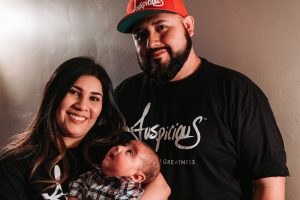
While there is no cure for Nathan’s condition, the diagnosis did change his treatment. His doctors performed two procedures that allowed him to get nutrition and aid food digestion. His diagnosis also allows his parents and doctors to provide ongoing specialized care and treatment, with the goal of making him more comfortable and giving him a better quality of life.
“At least we knew what was going on. So, what we’re doing as parents is we’re raising awareness for this, so that way there can be some research,” Martinez says.
Most parents whose babies were evaluated through Project Baby Bear were like Martinez and Aguirre in accepting rWGS. One reason why, according to Kingsmore, was where the initiative occurred: “California is progressive, and California is very much a technology state. So, by and large, we find the parents were accepting of genome sequencing.”
RCIGM oversaw education efforts at Rady Children’s and the other participating hospitals: CHOC Children’s—Children’s Hospital of Orange County in Orange; University of California, Davis Children’s Hospital in Sacramento; University of California, San Francisco Benioff Children’s Hospital in Oakland; and Valley Children’s.
“It’s really important for us to train the physicians and nurses at every site and to identify a champion at each site who kind of is the quarterback in that organization to help facilitate this locally,” Kingsmore says. “The test alone is not going to save the child’s life. It’s the test in the setting of a trained NICU team who are aware of how to administer the test and then turn the results into more effective treatments for those babies.”
“A fantastic success”
While Project Baby Bear provided rWGS services to 178 critically ill babies in California, it is only the tip of the iceberg.
“The true need is several thousand babies who would benefit from this technology, so Baby Bear was a fantastic success,” Kingsmore says. “We had some remarkable saves. But we now need to scale this up to every ICU in California and every Medicaid every medical baby who would benefit.”
To do so, the state would have to follow the lead of Blue Shield of California, which provides rWGS as a covered benefit for babies of parents enrolled with the private insurer. Kingsmore estimates 20 to 25 regional hospitals among California’s 344 licensed hospitals would also be needed to bring rWGS to every baby in the state.
But Project Baby Bear ended with no funding for another temporary program or a permanent successor.
“Currently there are no plans for a follow-up program resulting from the Project Baby Bear pilot,” Anthony Cava, a spokesman for California’s Department of Health Care Services, which oversees Medi-Cal, tells Clinical OMICs. “California is now experiencing significant fiscal challenges due to the COVID-19 public health emergency. Any effort to fund a new program based on the results from Project Baby Bear would be considered through the state budget process.”
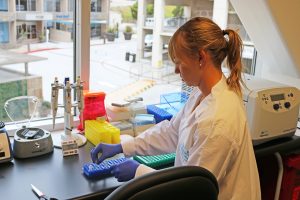
Meanwhile, RCIGM continues to provide sequencing to the project’s sites on a limited basis with the help of bridge funding from philanthropic donations. “Our understanding is that the door is not closed,” RCIGM spokeswoman Grace Sevilla says.
According to a Final Report submitted to the California Department of Health Care Services and released by Rady Children’s, Project Baby Bear provided diagnoses for 76 babies (43%) of those tested with rWGS. The testing led to a change in the management of 55 babies (31%) that resulted in fewer hospital days, fewer surgeries, and fewer invasive procedures. rWGS led doctors to discharge babies sooner, reducing the number of total days of hospitalization by 513 for the entire 178-baby cohort.
A total 35 rare conditions were diagnosed and the pilot helped doctors identify the exact cause of those rare genetic diseases in an average of three days, rather than the four to six weeks offered by standard genetic testing.
Some 10% to 15% of babies require neonatal or pediatric ICU care according to studies—of which up to one-third are likely to be affected by genetic diseases or congenital anomalies.
“For years, we have been underdiagnosing these children because we didn’t have a technology that was able to make a rapid diagnosis. Those tests were generally not ordered sufficiently frequently to understand how much we were missing,” Kingsmore says.
Beyond California
Through Project Baby Bear, California became the first U.S. state to fund rWGS for critically ill newborns. The pilot program has led to similar initiatives designed to provide babies with rWGS in Florida and Michigan.
In Florida, Nicklaus Children’s Hospital (Miami) is partnering with RCIGM to offer rWGS as a standard of care for children whose conditions may not be diagnosable through traditional genetic testing. With RCIGM as a collaborator, Nicklaus Children’s is sponsoring the enrollment-by-invitation Diagnostic Odyssey study (NCT03458962), designed to understanding the potential value of WGS in establishing genetic diagnosis by studying human genomes in children with suspected congenital disease, multiple-congenital anomalies, and/or multi-organ disease of unknown etiology.
In Michigan, Project Baby Deer—named for the state animal, the white-tailed deer—has gone beyond California’s initiative: “The study in Michigan will be open to all medical facilities that care for children and will go beyond Medicaid by engaging insurance companies in Michigan to show the value,” Caleb Bupp, M.D., medical geneticist at Helen DeVos Children’s Hospital, Michigan’s first hospital to conduct rWGS, told an internal publication, Impact: Journal for Physicians, in June.
In January, U.S. Rep. Scott Peters (R-San Diego) introduced a bill in the House of Representatives, “Ending the Diagnostic Odyssey Act of 2019” (H.R. 4144), which has been referred to the health subcommittee of the House Committee on Energy and Commerce. The bill would allow state Medicaid programs to cover whole genome sequencing services for patients under age 21 (states could limit the age further), and former foster youth under age 26 who were referred or admitted to an ICU or seen by a medical specialist for a suspected genetic or undiagnosed disease—or are suspected by a medical specialist to have a neonatal- or pediatric-onset genetic disease.
“Rep. Peters and the bipartisan, bicameral coalition of lawmakers who support the bill continue to work with their colleagues in both chambers to raise awareness about the benefits of whole genome sequencing for pediatric patients and the health care system more broadly,” Allie Polaski, Press Secretary to Peters tells Clinical OMICs.
Watch around the clock
While California now grapples with how to fund a much broader program, for Baby Nathan, despite there being no cure for his disease, understanding how the disease affects him has helped inform that care he needs. Nathan’s cyclic vomiting has resulted in his parents taking turns watching him around the clock, while still caring for Nathan’s older brother, who is 11 and has autism. On the day Martinez spoke about him, Baby Nathan had gone three months without a seizure, though his parents stay up with him out of concern for possible vomiting and/or choking.
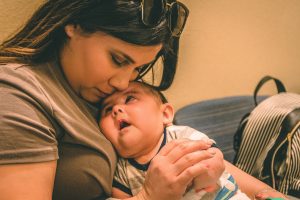
“I watch Nathan all night and my wife watches him all day. That’s the only way we can do it with him, being able to be safe,” Martinez says. “We like to focus on the journey, not the destination. We don’t really try to focus too much on the future, because it just brings anxiety. So, we just stick to what we can control.”
Since coming home in March 2019, Nathan’s weight has increased to 26 pounds: “He’s thriving as far as growth, and he’s eating correctly.” But he must be fed through a G-J tube and cannot have anything in his mouth, in order to avoid vomiting.
“He’s been through a lot, but he still finds the strength to smile, to push through,” Martinez says. “We use the word ‘auspicious’ a lot. We take it as ‘destined for greatness.’ Greatness can be defined in many things, but I think that he’s a perfect example of that. And that makes us feel that we’re on the right path, regardless of everything that he’s going through.”











